10 Best Walking Shoes for Diabetics in 2021
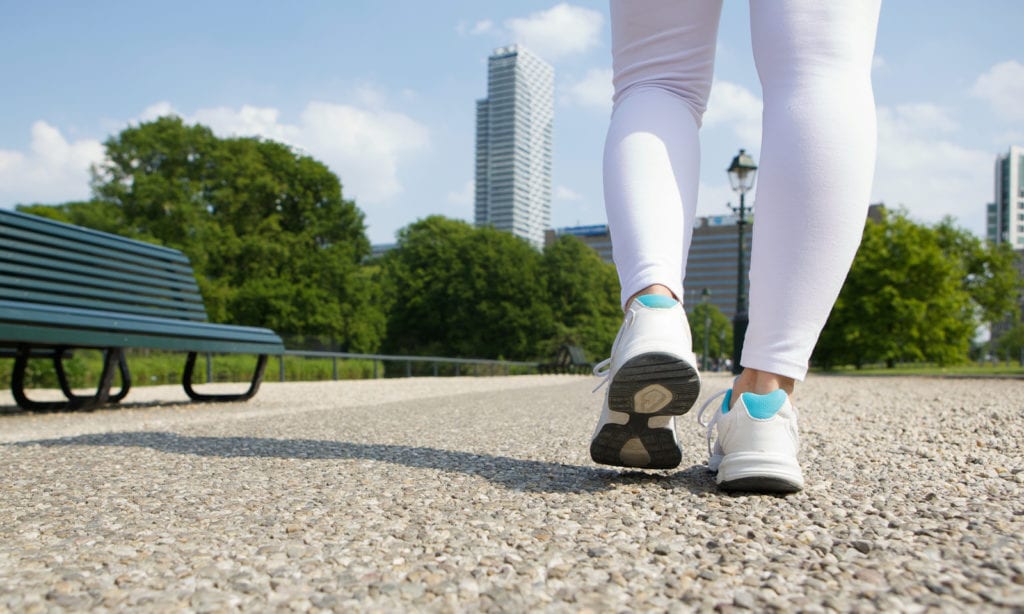
The incidence and prevalence of diabetes are increasing, with more than 135 million people affected worldwide. Diabetes can cause a lot of problems in your body especially with your feet. People with diabetes have a much higher chance of suffering from neurological symptoms that could make it very difficult to tell where they are actually walking. They might even possibly end up struggling to move or having circulatory issues as well, leading to serious health concerns.
If you (or a family member) have diabetes, you never know when or if these problems will strike, but the right kind of footwear can ward off some of the physical symptoms and risks to help you stay on your feet for longer. Here are ten pairs of some of the best walking shoes for diabetics, with some extra details about what makes them so useful.
View the Best Walking Shoes for Diabetics, Below.
- Skechers Men’s Afterburn Memory-Foam Sneaker
- Ryka Women’s Devotion Plus 2 Walking Shoe
- New Balance Women’s WW411v2 Walking Shoe
- Propét Men’s LifeWalker Strap Walking Shoe
- New Balance Women’s WW877-SB Walking Shoe
- Hush Puppies Men’s Gil Slip-On Shoe
- Propet Women’s Travelactiv Mary Jane Fashion Sneaker
- New Balance Men’s MW577 Hook and Loop Walking Shoe
- Skechers Performance Women’s Go Walk 4
- New Balance Men’s MW877 Walking Shoe
1. Skechers Men’s Afterburn Memory-Foam Sneaker
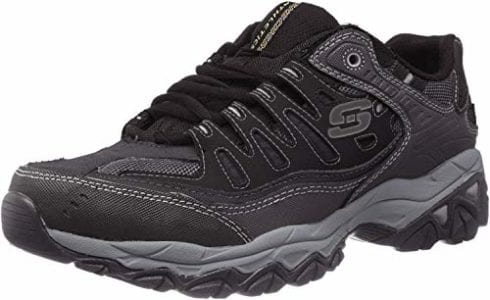
These men’s sneakers offer an excellent level of padding, using a mixture of memory foam and regular cushioning to keep your feet nice and comfortable on any surface. The lace-up design uses metal-topped eyelets for extra durability and strength, ensuring that they won’t come undone easily or wear out from regular use, and the leather used on the outside surface provides a good mixture of protection and flexibility.
Not only that, but the design of these walking shoes for diabetics makes heavy use of mesh, adding more breathability to help you stay cool on warm days. This, alongside the strong rubber outsole that spans the entire length of each shoe’s bottom, gives you a great balance of softness and rigidity.
While these walking shoes for diabetics might seem like normal trainers at first, they provide far more comfort and padding, making them ideal for people who want to keep their feet safe and comfortable at all times.
Check Price on Amazon ➞2. Ryka Women’s Devotion Plus 2 Walking Shoe

These walking shoes boast a colorful design and a mostly-mesh upper area, giving you an extreme amount of breathability without leaving your feet directly exposed. This section also has synthetic overlays to prevent it from collapsing inwards, adding some extra structure. The gum rubber sole has a slight curve and arch and uses EVA materials to withstand far more wear and tear, while the built-in insole uses an anatomical design that is meant to give your feet some natural support.
As if that wasn't enough durability already, these walking shoes for diabetics have an eight-piece skeletal rubber frame that is meant to help the shoes absorb damage and keep your feet away from any hard shocks or sudden bumps.
While they are mostly made for casual walking, these walking shoes for diabetics offer a huge range of benefits in terms of comfort and protection. This makes them perfect for anybody with foot injuries or pains, not just diabetics.
Check Price on Amazon ➞3. New Balance Women’s WW411v2 Walking Shoe
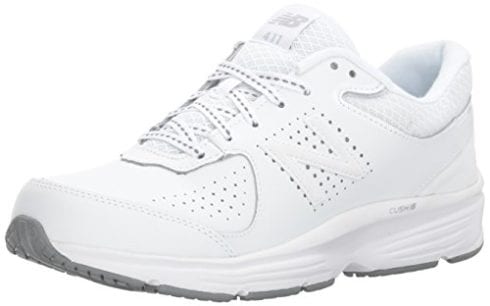
These standard walking shoes take a very simple shoe design – your average lace-up trainer – and improve it slightly without becoming too extreme. The regular lace-up system means that they will be familiar to almost anybody who’s owned trainers before, and the strong rubber sole helps you keep your grip on slippery or smooth surfaces.
They are very low-profile, both visually and in terms of size, meaning that they can keep your feet feeling really comfortable without looking like colorful exercise gear. The single-tone color means that they will fit in with a vast range of outfits, both around the house and out in public, and the basic yet comfortable insole provides even more comfort during long walks.
Sometimes, the best walking shoes for diabetics are the simplest options, and this is no exception, especially if you want something you can wear as part of your everyday outfits.
Check Price on Amazon ➞4. Propét Men’s LifeWalker Strap Walking Shoe

These strap-based walking shoes use an all-leather design that is both comfortable and stylish, giving you the best of both worlds while still fitting into most normal outfits. The brushed nylon used as lining adds some subtle protection and extra visual appeal, while the contoured stabilizers used on the heels make it really easy to keep your balance.
Alongside that is the very easy-to-use straps, which allow for much faster loosening and tightening than laces – this is perfect for shoes that you will want to be able to put on at a moment’s notice. Bolstering this is the memory foam used as the insole’s top layer, which allows these walking shoes for diabetics to mold to your foot shape even if you are suffering from issues that make normal shoes uncomfortable.
These shoes are very simple and very effective: you can put them on or take them off in seconds, and they are extremely comfortable once the memory foam adjusts properly.
Check Price on Amazon ➞5. New Balance Women’s WW877-SB Walking Shoe
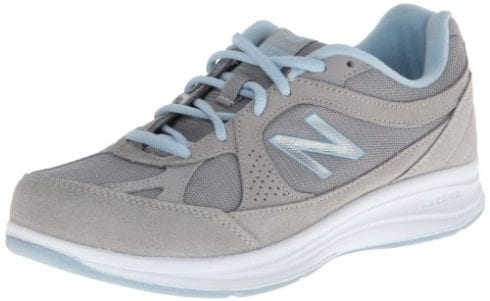
These women’s shoes use a mixture of mesh and suede to create a comfortable, stylish and durable set of footwear. The strong rubber sole is able to take a lot of punishment before showing any signs of wear and tear, while the shock-absorbing insole reduces the amount of force going into your feet with every step.
Thanks to the breathable mesh used all over their design, these shoes are great for warm weather, and the wide toe box makes them easy to wear even if you are dealing with foot injuries or just want more room to move around. While the visual design isn’t anything extreme, it is a nice mixture of a classic trainer and a casual mesh shoe.
These shoes are perfect for diabetics who want to combine comfort, breathability, and style together, rather than choosing one of the three over the others.
Check Price on Amazon ➞6. Hush Puppies Men’s Gil Slip-On Shoe
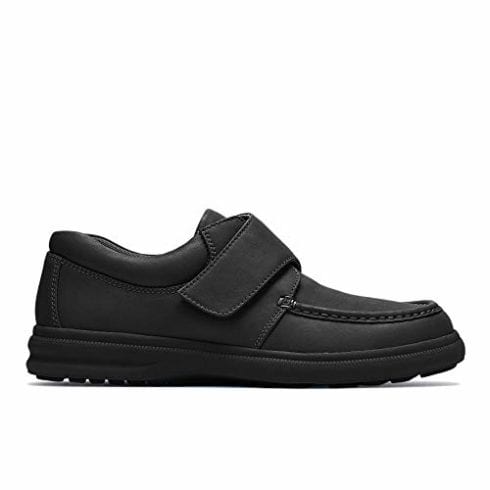
These slip-on shoes have a hook-and-loop based strap that is extremely easy to adjust, letting you slip them on and have them tightened in no time. The EVA insole adds a huge amount of durability and physical protection to the shoe, keeping the bottom of your feet safe from all kinds of harm without being too bulky or heavy to use for long periods of time.
Even better, the insole is removable, so you can replace it with your own if you have a medically-prescribed orthotic insert. The synthetic outsole of these walking shoes for diabetics is made with lightweight and shock-absorbing materials, reducing the amount of pressure on your feet and making it far easier to move quickly, regardless of the situation.
Slip-on shoes are perfect for dozens of different situations, but the amount of protection and shock absorption on offer here makes these some of the best walking shoes for diabetics with foot issues.
Check Price on Amazon ➞7. Propet Women’s Travelactiv Mary Jane Fashion Sneaker
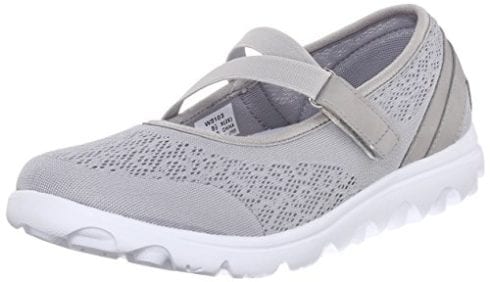
These sneakers use a slightly unusual design that has perforated sections on the front and at the heel, adding more ventilation without turning into open sandals. The low design means that there is no neck to rub against your ankles and shins – however, despite this, the shoes still get a decent amount of support from their design. This is backed up by a removable insole, which you can replace with any of your preferred choices.
The outsole of these walking shoes for diabetics is made of lightweight synthetic materials, meaning that it won’t add to your weight while you are on the move. It is also flexible, helping you keep your grip on awkward surfaces or natural terrain where other shoes might often slip.
These sneakers are small and simple, but boast an excellent design and plenty of comfort – more than you'd expect. This makes them an excellent replacement for older casual and informal shoes that might feel uncomfortable on your feet now.
Check Price on Amazon ➞8. New Balance Men’s MW577 Hook and Loop Walking Shoe
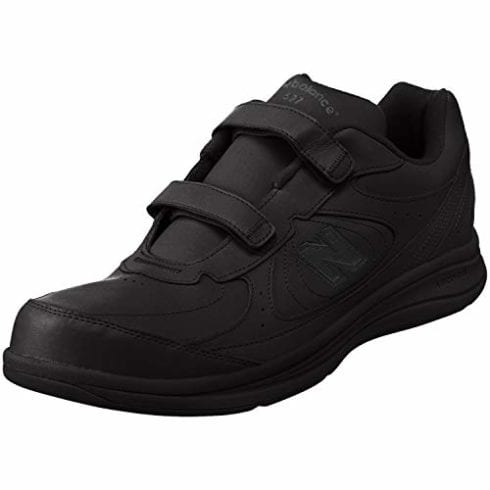
The leather used in these walking shoes adds some more resilience and durability to standard footwear design, but that isn’t all it offers. The easy-to-adjust laces and soft, padded collar help you feel comfortable regardless of your foot and ankle size, while the extra padding on the tongue keeps the top of both feet safe. The midsole is designed for as much stability as possible, while the outsole brings the strength and shock-absorption you’d expect.
Despite its single-color design, these walking shoes for diabetics take a lot of inspiration from New Balance’s other athletic gear, meaning that they are just as flexible and comfortable as their “sporty” footwear. This makes them far more versatile in day-to-day life than generic walking shoes.
These shoes are comfortable and padded in all the right places, but still provide plenty of protection and support when necessary. Not only that, but they are flexible!
Check Price on Amazon ➞9. Skechers Performance Women’s Go Walk 4

These slip-on trainers use a two-tone design that looks surprisingly casual, allowing them to blend in with a huge range of different outfits. They are lightweight and flexible, avoiding anything that might feel uncomfortable or painful on your feet, and use a flat-heeled design for greater stability on almost any surface. The EVA sole provides a huge amount of physical protection against shocks and tough bumps, while the slip-on design means that you can quickly slide them on and off whenever necessary.
Not only that, but the upper section of each shoe is partially mesh, providing a seamless and well-ventilated place for your feet to rest without issue. The insole of these walking shoes for diabetics is even lined with bamboo to combat odors.
These shoes might seem unusual at first, but they are actually incredibly versatile, giving many women a great set of footwear that they can use in almost any situation.
Check Price on Amazon ➞10. New Balance Men’s MW877 Walking Shoe

These simple shoes are designed with walking in mind, using plenty of cushioning and protection to keep you safe in the long term. The added shock absorption from the ABZORB midsole means that you do not need to worry about causing pain in the bottom of your feet, and the additional padding around the collar and tongue help you stay comfortable while you are walking.
These walking shoes for diabetics use a tough rubber sole that can withstand much more damage than you might expect, as well as plenty of mesh to add more ventilation. If that wasn’t enough, they also keep the same lace-up design of other standard trainers, making them very familiar to almost anybody who might need them.
These shoes are another example of a standard design done right, offering excellent ventilation and protection without changing so much that they are unrecognizable.
Check Price on Amazon ➞Walking Shoes for Diabetics Buyer’s Guide
Buying shoes if you have diabetes isn’t the same as buying shoes for a non-diabetic person. While some of the requirements could be the same, there is a lot more that you will need to be aware of, especially if you are already suffering from foot problems.
However, here are some key things you should look for if you are looking shoes especially if you have diabetes and want to make sure your shoes are suitable for your day-to-day life.
Prescriptions
If you have diabetes with other medical conditions like neuropathy or PVD (Peripheral Vascular Disease) a doctor can write a prescription for you for a certain kind of shoe and inserts. You can then go to a local shoe store that specializes in diabetic shoes to have it filled. On the other hand, if they just say that you should avoid a specific type of shoe (or a certain feature a shoe might offer), then it is vital for you to avoid it at all costs and follow medical advise. Your doctor will generally know more about your condition than you do, and they are making those recommendations for a good reason.
Many people will also get insoles prescribed to them too, either to correct issues or to prevent common problems that can arise especially in diabetic people. If you have these insoles, you should be using them as often as you can – this might mean that certain shoes with built-in insoles become a problem especially if you are not able to remove them yourself so it is best to discuss this with your doctor that wrote the prescription.
The Fit
Obviously, it is always good to make sure that your shoes fit you, especially if you plan on wearing them quite often. However, when conditions like diabetes are involved, you never know what a poorly-fitting shoe might cause.
If a shoe is too tight, it will push down on your skin and rub against exposed areas. This can lead to all kinds of skin problems, and can also re-open cuts or other issues that have just started to settle down. In fact, in really bad cases, a shoe might even weaken your skin enough to the point where it starts bleeding on its own – although you could feel the pain well before then or not if you have neuropathy.
On the other hand, if a shoe is too loose, a similar problem can happen: you will need to deal with rubbing on your skin, as well as a lack of proper balance and support. Depending on what issues you are dealing with, this can lead to similar injuries as a tight fitting shoe.
The Purpose
Are your shoes meant for walking or running? Do they have the right kind of support for long-distance walks, or are they supposed to be used in small bursts? And perhaps most importantly, how do you tie them? The argument between laces and hook-and-loop straps might seem minor, but it can make a huge difference, especially if you start suffering from foot issues or diabetes problems that make it hard to tie a lace. That being said, laces offer more stability and reliability and can be adjusted to very specific sizes, so they can prove to be more useful than a strap-based design in many situations.
Another example is you buy hiking boots. These are great, and can often be incredibly comfortable and protective, but they are also very bulky and don’t offer much flexibility. An open toed sandal is a direct opposite, providing a great amount of freedom at the cost of any real protection and safety. Exercise shoes are the most common choices for day-to-day use, but these can be split into different categories and types too.
Basically not all shoes are useful for everything or everyone, and many of them have significant downsides or limitations. This isn’t something that you can fix but if you put the time in and read these reviews you will probably be better off. Only a small amount of people can get through their daily life with a single pair of shoes, so it is very important to carefully decide what will best work for you especially if you have diabetes.
The Materials
Of course, the materials used in your shoe also matter. A good insole can provide plenty of comfort and padding, but one that uses stronger and more rigid materials is very likely to hurt your feet. In the same vein, a shoe with a sturdy outsole can be very protective, but one that uses softer materials won’t absorb shocks in the same way.
There is a lot to cover regarding materials, far too much to list here, but there is always one rule you should follow: choose whatever gives you the best results. Just because a shoe is made of a fancier material doesn’t mean that it is better, in the same way that a sole with a technical-sounding material name isn’t necessarily going to be better than thick rubber. If you are diabetic, the results and effectiveness matter more than style.
Expert Tip by Dr. William Naughton
When you get new shoes, try wearing them around the house for around twenty to thirty minutes. This will help you identify problems that they can cause on your feet, even if it is just small red spots. If you are a diabetic, report any issues from your shoes to your doctor.
Did You Know?
Most people have one foot that’s half a size bigger than the other. If you measure by your smaller foot, your shoes might not fit, so always try to use the bigger one when possible.
Disclaimer
The content is not intended to be a substitute for professional medical advice, diagnosis, or treatment. Always seek the advice of your physician or other qualified health provider with any questions you may have regarding a medical condition.